What Is Status?
Status is an open source messaging platform and mobile interface to interact with decentralized applications that run on the Ethereum Network. This document presents a utility network token for Status, the first ever mobile Ethereum client built entirely on peer-to-peer technologies.
The messenger form-factor is chosen to make Ethereum feel as familiar as possible to the average smartphone user, while providing a flexible platform for DApp developers, aimed to maximise the amount of daily use of Ethereum’s public blockchain. The Status Network token is a modular utility token that fuels the Status network.
- Overview - Table of Contents
- What Is Status?
- Getting Started With Status
- How To Get A Status Wallet?
- Status Resources
- How To Buy Status?
- Latest Status News
This includes a Decentralized Push Notification Market, Governance of the Status client, Community Curation of content, along with social communication tools such as Tribute to Talk. We also propose a fiat-to-crypto 'Teller Network', DApp Directory, Sticker Market, and demonstrate our research on a User Acquisition Engine to grow the Network.
Prevalent on the internet today are social bots, a type of automated software that controls a social media account, designed to advocate certain ideas, support campaigns, and sway public relations. These bots pollute online discussion by lending false credibility to their messages and influence of real users (Ferrara et al. 2016a, Aiello et al. 2012). </p

Recent studies quantify the extent to which automated systems can dominate discussions on Twitter about topics ranging from electronic cigarettes (Clark et al. 2015) to elections (Bessi and Ferrara 2016). Recent conservative estimates claim 15% of all Twitter users are said to be bots (Varol and Ferrara 2017). Twitter has 319 million monthly active users as of 2016, suggesting that 47.8 million users are bots. This poses a threat to the legitimacy of the media we consume.
The problem of social bots and media manipulation serves as a catalyst in re-evaluating how we design our social networks and is just one symptom that is systemic in the user-asproduct business model. In this paper we will present our ideas for the next generation social network, the socio-economic network.
Carl and Jarrad, the co-founders of Status, have had a working relationship for 6 years on various projects, and 3 of those years were spent operating a software distribution network, driving over 20 million installs to various software oferings, the profits of which were used to fund Status and our team of 10 until this point.
During the operation of this business we were uniquely positioned to see firsthand how personal data on the internet is bought and sold and how users are acquired and retained.
Why Ethereum?
Before stakeholders can communicate and transact with one another they require a medium in which to do so. Traditionally this has always been done by a trusted intermediary (the Owner). With the advent of the Ethereum public blockchain and its related sub-protocols forming the backbone of Web 3.0 (Swarm; for decentralized file storage [Trón, Fischer, Nagy, Felföldi 2016], and Whisper, for peer-to-peer communication [Wood 2015]), we can now provide users a medium of agreements that is decentralized, permissionless, trustless, with fair access and is cryptographically verifiable.
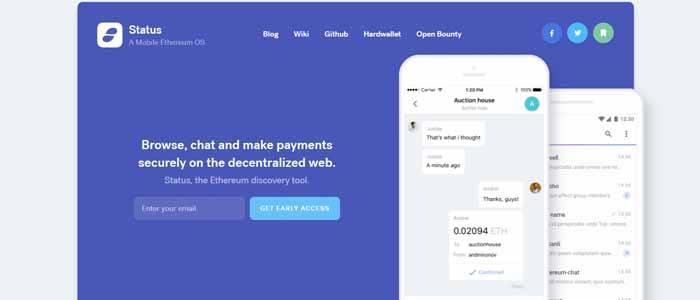
A medium that maintains an ‘immutable’ transaction record as long as the majority of the Ethereum network collectively agrees. With Ethereum, the world possesses the technology necessary to build a better model for the Internet. We believe the Ethereum public blockchain will continue to permeate all NBUUFST of financial technologies, legal systems, the internet of things and decentralized applications.
Ethereum is ultimately a social technology, and for its realized impact to equal its perceived potential we need to maximise its utility for non-technical users, it needs to be ubiquitous and always accessible, and it needs to become part of our daily lives - without compromising on decentralization.
The Status Mobile Ethereum Client
To introduce the next part of the infrastructure we need to work back from people, we need to understand how they interact with technology and how they live their daily lives. Smartphones are the new personal computer and are increasingly the access point to the digital world for citizens of both developing and developed nations alike.
As of 2014, smartphone usage surpassed desktop usage and continues to trend upwards (Comscore 2016). Amongst the growing populations with access to smartphones and mobile internet, messengers have become the primary means of digital communication, and are poised to surface as the new gatekeepers to economic trade. Messengers as an application category now boast more users than web 2.0 social networks (BI Intelligence 2015), the highest retention rates (Flurry 2015), and are where smartphone users are spending an increasing amount of their time (iResearch 2016).
- Overview - Table of Contents
- What Is Status?
- Getting Started With Status
- How To Get A Status Wallet?
- Status Resources
- How To Buy Status?
- Latest Status News
In China, WeChat now boasts 889m active users with 90%+ penetration rates in China's largest cities. WeChat Pay is also now used by 93% of WeChat users for ofline purchases in China's largest cities (Penguin Intelligence 2017, CNTechInsights 2017). On average WeChat users spend 66 minutes per day within the application. WeChat has become tightly integrated into all aspects of daily life in China. One can arrange social life, banking, business activities, transport and payments directly from within it.

However, WeChat is a closedsource, proprietary interface, and its centralized architecture leaves it open to coercion and corruption. The trend towards messaging-as-a-platform epitomized by WeChat has not yet reached most of the West or the developing world. Status aims to be the first messaging platform to achieve this, using a decentralized and community governed approach. Utilizing the messaging-as-a-platform user experience, the Status mobile Ethereum client presents a familiar feel that’s convenient and well suited for mass adoption.
Status respects the Users rights by being open source and free, and unlike its centralized counterparts, it puts users in complete control of their own personal data. Status acts as a node that connects directly to the Ethereum network, adhering to our guiding principles of fair and permissionless access, decentralization and trustlessness. Status is an open source messaging platform and web 3.0 browser, designed to interact with decentralized applications that run on the Ethereum Network.
Built using decentralized technologies, Status provides a window into the emerging decentralized web. As an ecosystem of decentralized applications, Status becomes a gateway to undeniable free trade, peer-to-peer payments, and encrypted p2p communication for anyone with a smartphone and internet access. Status and Ethereum provide the foundation necessary to give all stakeholders in a socioeconomic network equal footing. The Status application, which is currently in alpha, and available for Android & iOS, allows users to:
- Send and receive encrypted messages, smart contracts, and payments.
- Browse, chat, and interact with decentralized applications and decentralized chatbots.
- Store and control crypto-assets with the built-in Status Wallet.
Decentralized Push Notification Market
Taking a hard stance on decentralization in the client isn’t without its challenges. Due to the peer-to-peer nature of the Ethereum communication subprotocol, Whisper (SHH), simple expected user experiences, such as being notified when a friend has responded to your messages, have to be themselves redesigned in a decentralized context.

With the new Whisper V5 protocol, we can now delegate nodes to do ofline inboxing (storing messages while clients are ofline) and we will extend this ability to support push notifications. This allows us to establish a market for push notification providers.
For service, stakeholders will deposit SNT with a provider, who may charge microtransactions for notification and storage. This afords stakeholders the right to choose which nodes in the network will provide the service for them, and what kind of push notification providers they would like to use, perhaps choosing Deepstream over Google or opting completely out of the service to maximize their privacy.
We recognize that in a model where the User is no longer the Product, paying for push notifications may initially seem like a hurdle, as Users in existing platforms currently get this ‘for free’. Instead we make the costs explicit to the User and don’t exclude possibilities where a push notification node could build a business on top of the infrastructure, ie. ofer the service ‘for free’ by the User viewing ads to pay for push notifications.

The end result is that we give the User a choice. Status implements an application protocol for message re-delivery, so as soon as both parties are online in the network, messages are exchanged and history is updated. Technical details of the implementation can be found here.
Status Teller Network
One of the core hurdles to the adoption of cryptocurrency is the dificulty in obtaining it. Ease of access is necessary to transition our economies from fiat to digital currency. In order to solve this problem, we propose the implementation of the Status Teller Network, a D"pp inside of Status, which provides borderless, peer-to-peer fiat-to-crypto ‘Teller Network’.
The Teller Network allows Stakeholders in the Network to find nearby users to exchange their cash for digital assets and currency, giving any smartphone owner in the world the ability to take control of their personal wealth. In this sense, Status becomes a piece of a “Web 3.0” banking infrastructure and creates a global people-as-ATM network. This has particular utility in developing markets where cashbased economies are prevalent and credit card penetration remains low, tackling the famous ‘last-mile’ of the remittance market.
- Overview - Table of Contents
- What Is Status?
- Getting Started With Status
- How To Get A Status Wallet?
- Status Resources
- How To Buy Status?
- Latest Status News
By introducing the Status Network Token, we can not only provide use-cases that were previously impossible in web 2.0 environments, but also address some of the core problems created by incentive misalignment and sock puppet bot creation that plague social networks today. This begins at a Governance level, by empowering stakeholders in the Status Network; giving them a real voice and ability to influence the direction of the software as it develops.
The Status Network Token (‘SNT’) will be distributed at a rate of 10,000 SNT per 1 ETH to participants in the Contribution Period, and is expected to begin on June 20th. The Contribution Period will run for 14 days, or within 24 hours of the first ceiling of 12M CHF
Ethereum is a smart contract platform where developers can build and deploy decentralized applications or dApps that do not rely on any form of centralized authority. These dapps are hosted by Ethereum nodes.
So far, we’ve seen dozens of projects and applications being developed and launched on the Ethereum network. From the DAO, to FirstBlood, Iconomi, Singular-DTV, Gnosis, Augur, Matchpool, and many more.
However, for the blockchain enthusiast that wants to interact with all these dApps, doing so can be challenging. That’s where Status comes in! Status is an Android & iOS mobile client built on Ethereum technology and for Ethereum users.
“With Status your mobile device becomes a light client node on the Ethereum Network, enabling you to access Ethereum’s entire ecosystem from anywhere.”
Although all of these dApps we’ve just mentioned are pretty exciting by themselves, they are even more so when they can come together to form an ecosystem. This is what Status is building, an intuitive user interface where mobile users can access all of these decentralized applications in one place.
Status runs go-ethereum directly from your mobile device, turning your mobile phone into an Ethereum node, which means that validation of blocks is done on the client side.
Status will be both a browser for Ethereum dApps and a decentralized messenger. The hybrid browser and messenger system is used to increase user acquisition and outreach, staying agnostic and as close as possible to the principles Ethereum embodies.
“When Carl & Jarrad looked at how to achieve mass adoption for a client. We looked at things such as where the people are, how they behave on their devices, time spent on pc vs mobile - as of 2014 more time is spent on mobile than desktop, and of that time - a THIRD of it is spent within Instant Messengers.”
The decentralized messenger will allow users to find each other globally and to transact and communicate with each other with no restrictions.

On the Ethereum browser side, Status will be able to run basically any dApp that runs on Mist or MetaMask. So far, there are multiple dApps listed on Status like uPort, Gnosis, Oasis Exchange, Ethlance, Aragon, Etherisc and Ujo. However, Status is completely open source and anyone can list their dApps at will.
Overall, the Status project is extremely exciting and is the first step towards complete decentralization in every aspect of our online habits, allowing users to carry on with their “digital” activities without the need to ever leave the Ethereum ecosystem and be subject to middleman fees, hacks, censorship, and so on, which has become the norm in online apps and social media.
Status wants to solve the problem that we (the users) have different identities all over the internet. It criticized that we have spreaded to many personal information all over various platforms. Status wants to create a digital hub where we can use various services based on the Ethereum Network.
What is the functuality for SNT:
- Governance over the Status Client
- Username registration over ENS
- Community curation and content discovery
- A Decentralized Push Notification Market
- The Status Teller Network
- The Status Sticker Market
- The Status DApp Directory
- Access to features such as Tribute to Talk
- The Status Acquisition Engine (Research)
How does Status wants to solve this problem?
Status is an Ethereum based platform. You can say that Status is a digital hub for apps based on the Ethereum blockchain.
Who are the core contributors?

Status co-founders Carl Bennetts and Jarrad Hope had been working together for 6 years on various software projects before deciding to start creating Status together.
Status started out as 8 core team members, headquartered in Singapore.
During 2017, however, the Status team exploded into 55 core team members working around the clock and around the globe.
What is Ethereum?
Ethereum is a decentralized database which stores information about past transactions and smart contracts between users of the Ethereum blockchain. Ethereum stores the data on a globaly spreaded peer to peer network. For more information about Ethereum, check out.
Who owns Status?
Status is owned by the company Status Research & Development GmbH based in Switzerland and by its contributors who buy SNT (Status Network Token)
- Overview - Table of Contents
- What Is Status?
- Getting Started With Status
- How To Get A Status Wallet?
- Status Resources
- How To Buy Status?
- Latest Status News
It is said that Status is in the App is in the Alpha phase. How can I test it?
Take a look at here: http://contribute.status.im/
Is there an Android Alpha?
Yes there is. Take a look here: https://test.status.im
Is there an Apple Alpha?
Yes there is but unfortunately there are no slots for the Alpha due to a limited amount of codes.
What is the DApp Directory?
The DApp Directory can be compared to an App Store where you can search for applications based on the Ethereum blockchain.
What apps can I use within Status?
On the website it is said that „uPort, Gnosis, Oasis Exchange, Ethlance, Aragon, Etherisc and Ujo” can be used.
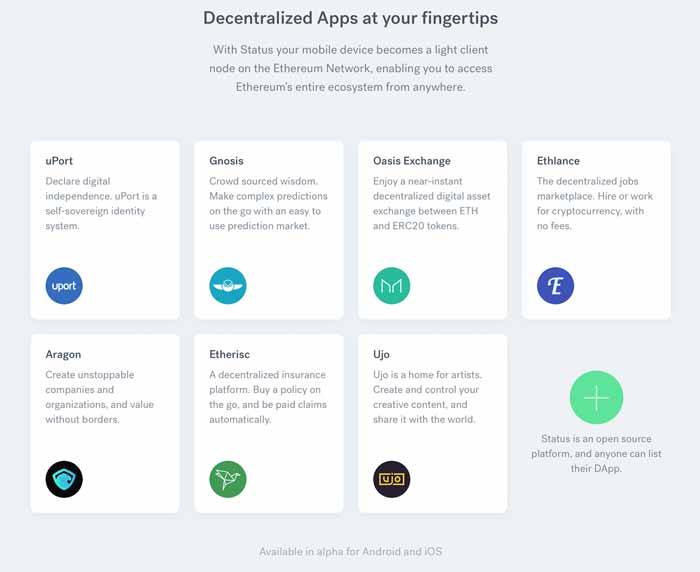
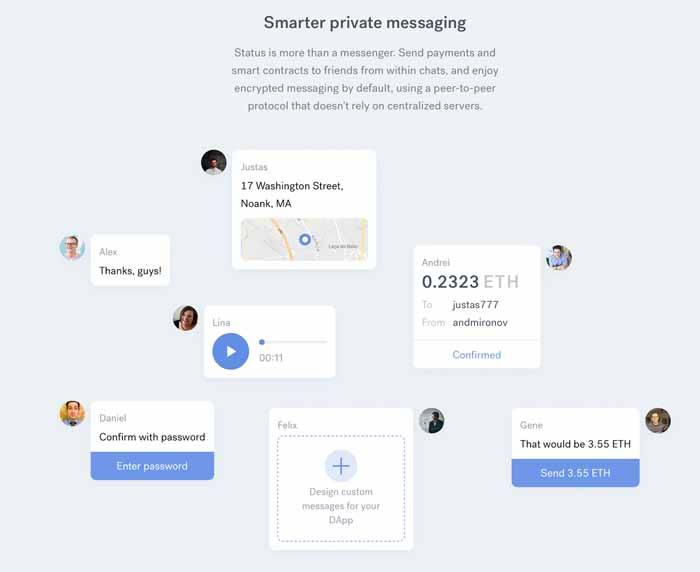
Status is calling itself “the Ethereum discovery tool.”
You can think of Status as a mobile operating system built for Ethereum. Status enables your mobile device to become a light client node on the Ethereum network. The result? Access to Ethereum’s entire ecosystem from anywhere.
Status is striving to lower the barriers of entry on Ethereum, allowing mass adoption of the Ethereum blockchain in order to facilitate the transition to a more open internet.
The creators behind Status are working towards bringing a decentralized world to life.
Status essentially combines a messenger and a browser that allows everyday smartphone users to use decentralized applications, also known as dapps. Status is available on both Android and iOS.
Status users can safely send, receive, and store Ether and other Ethereum crypto assets on their phone. They can also discover nearby Status users to exchange currency, services, and ideas locally.

Status is also an encrypted private messenger that allows you to send payments and smart contracts to friends from within chats, using a peer-to-peer protocol that doesn’t rely on centralized servers.
In both the US and globally, there are more people actively using messaging applications than even social media networks. The creators of Status took note of this, making the decision to give Status a focus on messaging and chats.

Status is an open-source platform, which means anyone can list their dapp for download. If you have Status on your phone, you instantly have access to download a plethora of useful and ingenious dapps.
For example, you could download Ethlance, a decentralized job marketplace that allows you to hire or work for cryptocurrency, with no fees. And because it’s all open source, the Status community will be able to directly help shape and evolve Status to fit their exact needs. The sky’s the limit!
Right now, Status is in its alpha stage, with about 14,000 alpha downloads around the globe. The beta version is currently in the works.
Now let’s talk about the Status coin itself. The Status Network Token (SNT) is a modular utility token that fuels the Status network, adding value to the platform and driving network effects. SNT possesses an interesting feature—the ability to easily spawn new tokens that have the same balance distribution as the parent token at any given block number.
History of Status
The first time the world heard about the idea of Status was September 2016, at DevCon2, an annual conference for developers on the Ethereum blockchain. Co-founders Carl Bennetts and Jarrad Hope gave a presentation revealing the plans for their Ethereum light client.
On May 29, 2017, Status was announced to the public. Since then, nearly 14,000 people around the world have downloaded Status alpha, and over 50,000 people are on the current alpha waitlist.
In 2017, Status announced partnerships with both Sirin Labs and the Enterprise Ethereum Alliance.
Competitors and Challenges
A very similar project to Status is a platform called Toshi, which is also an open-source browser for the Ethereum network. Status does have an advantage over Toshi, however, as Status has a decentralized messaging system, while Toshi does not.
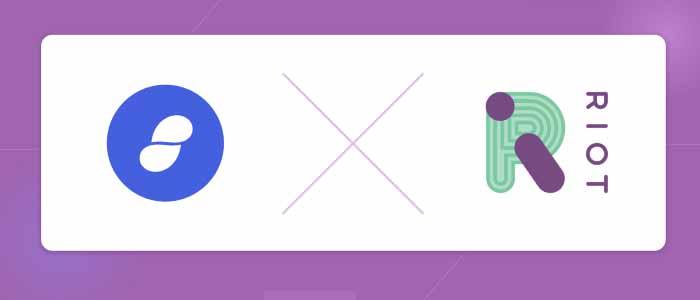
Most likely, the biggest challenge for Status right now is gaining mass adoption, and not just getting used by a small group of crypto geeks. Most of the world still doesn’t know what the blockchain even is, or why they would benefit from having a decentralized mobile operating system on their phone. Hopefully the team has a great marketing plan to spread the word about why the average person should move to use Status.
Getting Started With Status
Status will be a messaging platform modeled after the popular Chinese mobile app, WeChat, which had 889 million users at the end of 2016. Status aims to create a level, open marketplace driven by socio-economic incentives where users control their information and how they share it.
The object of the token sale, the Status Network Token (SNT) will be used to purchase services over the network. Unlike centralized social network models, in which the owner monetizes user information in order to develop services that keep them on the network, Status will have an open, competitive marketplace for social network services providers. Here is a brief overview of SNT’s utility.
- Purchase access to services like push notifications.
- Register a username on the network
- Vote in protocol decisions in a liquid democracy
- Deploy semi-trusted, token-based group chats
- Set a minimum amount of SNT that an unknown user must stake in order to contact them, reducing spam.
- Opt in for community developed curation mechanisms
- Become a seller on a peer-to-peer, crypto-fiat exchange network
- Participation in the Status sticker market
Status is a mobile operating system that will completely change the way the world interacts with the Ethereum network. Designed as a decentralized browser and private messenger, Status allows you to connect to the entire Ethereum network right in the palm of your hand.
Operating as a light client node on Ethereum, Status provides you access to all of Ethereum’s decentralized applications (dapps) through an app on your smartphone. It opens the door to mass adoption of Ethereum dapps by targeting the fastest growing computer segment in the world – smartphone users.
Smartphone users will quickly realize that utilizing Ethereum and its dapps has never been so easy and convenient.
The Status network breaks the unbalanced architecture of legacy social media platforms. These traditional networks give almost all control to owners and advertisers; users are left with little power over what personal information they share. Additionally, legacy users have little voice to influence the evolution of the platform.
The Owner
The owner is normally the creator of the network. The owner’s main two roles are to recruit and retain users to the social media platform. After bringing users into the network, they focus on extracting value from users.
The Advertiser
The advertiser, referred to as the data broker by Status, enables the owner to extract value from the network and its users. The advertiser plays a key role in ultimately sustaining the social media network by purchasing user data or purchasing ads for products and services.
The User
Users are those who use social networks to connect with friends or to share their own special interests. In this model, users are almost powerless to control how the network is developed or the information they consume.
Forget about legacy social network models that only empower the owners and advertiser. With the issuance of Status Network Tokens (SNT), Status enables its users to become stakeholders in the network they participate in.
- Overview - Table of Contents
- What Is Status?
- Getting Started With Status
- How To Get A Status Wallet?
- Status Resources
- How To Buy Status?
- Latest Status News
The platform’s design allows the behavior of its social network and software to be aligned with the interests of its users. As a Status user, you’re in complete control of what information you share, and you can vote on the future development of its decentralized network.
How To Get A Status Wallet?
In November 2017, Status introduced the Status Hardwallet. Unlike other crypto-wallets that require a wired connection to perform currency transactions, the Status Hardwallet lets you store, send, and receive cryptocurrencies without contact with built-in-NFC.
Other highlights of Status’s Hardwallet include being mobile ready and completely open source; the Hardwallet’s code can be inspected and edited to suit exactly any user’s needs. The Status Hardwallet works with ETH, SNT, and ERC-20 tokens.
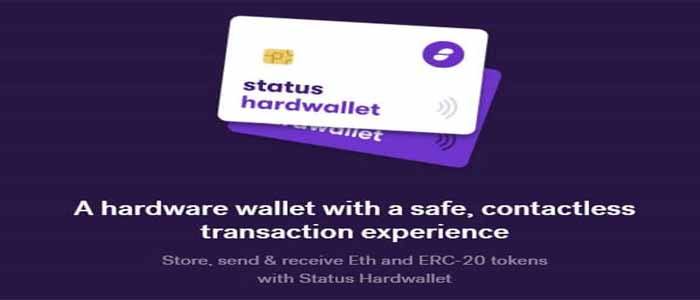
In November 2017, the team also announced its launch of Status Open Bounty. This program provides open source collaboration solutions for both developers and organizations to finish projects.
Allowing organizations to decentralize their development, Status Open Bounty gives developers a list of projects that they have the option to contribute towards. It pays rewards in SNT or the ERC-20 cryptocurrency of your choice without third-party fees.
In conjunction with Status Open Bounty, the team also launched a one million dollar bounty fund completely dedicated to funding open source projects.

Where to Store SNT Tokens?
Generally, it is safest for investors to store their cryptocurrency holdings off an exchange.
As an ERC20 Token, SNTs must be stored in an Ethereum wallet. Popular software wallet choices that support ERC20 tokens include MyEtherWallet and MetaMask.
Providing the highest level of security, hardware wallets such as the Ledger Nano S or Trezor can also be used to store your tokens.
Status Resources
How To Buy Status?
SNT is currently available for trade on many online exchanges, including Huobi, Binance, and Bittrex. Click here for the full list of updated Status exchanges.
Alternatively, if you already have some ETH, then you can use Shapeshift to exchange your ETH into SNT.
SNT can be stored on any wallet that supports ERC20 tokens, such as MyEtherWallet.
The Status team is working on perfecting a Status Hardwallet, allowing safe, contactless transactions of ETH and ERC20 tokens. It’s currently in the beta stage.
Status’s Contribution Period began June 20th, 2017. Intended to run for weeks, the Contribution Period sold out in less than a day. SNTs were distributed at a rate of 10,000 SNT per 1 ETH. In just a few hours, the project had raised a total of 99 million dollars.
Status has a total supply of 6,804,870,174 tokens of which 3,470,483,788 currently available.
When SNT first began listed on exchanges in July 2017, it began trading for roughly for $0.05. For the next five months, SNT performed poorly as its average price stuttered in the $0.03 to $0.04 range. Starting an impressive bull run in early December 2017, SNT quickly skyrocketed all the way to an all-time high at 65 cents.
Since the new year, the price of SNT has consistently dropped as most the cryptomarket has fluttered downward. At the time of writing, the price of SNT has fallen all the to 18 cents. SNT’s 2018 negative price movement has been highly correlated to the price of Bitcoin plunging over the past month.
Latest Status News

Wins Exclusive Spot on Netexplo’s 2018 Grand Prix Award Shortlist, COO speaking at UNESCO House on February 13th
At Status, we see a future that’s more open and equitable thanks to the power and promise of the decentralized Web. That’s why we’re honored to be selected for a 2018 Grand Prix Award at the 11th annual Netexplo Innovation Forum. Nabil Naghdy, our COO, will accept the award and speak at the UNESCO House in Paris on February 13th — and you can watch it live.
An independent organization based in Paris, Netexplo studies the impact of digital tech on society and business; its corporate and academic sponsors from around the world represent some of the most influential figures in technology. We’ll share the spotlight with nine other innovative projects (out of more than 2,000 considered by Netexplo’s international network of experts), including new efforts in AI, big data, biotech, IoT, robotics, and quantum computing.
UNESCO (the United Nations Educational, Scientific and Cultural Organization) is a global agency comprised of 195 member states with a mission to contribute to the building of peace, the eradication of poverty, sustainable development, and intercultural dialogue. We’re thrilled to be associated with their important global goals at their headquarters in Paris.
“We’re honored to receive this recognition,” Nabil told us as he prepared to share his thoughts at the UNESCO House. “Our team is committed to the long-term vision of Status, a vision of a world where everyone with an Internet connection has access to the decentralized Web. We’re committed to building an open source platform that’s as easy to use as your current chat app. We believe Status will be transformational — fundamentally changing how people use the Web — and we’re very proud to be a part of this special event with so many other amazing innovators at the UNESCO House.”
If you’ve been following Status, then you know we have big, tangible goals — and we believe decentralization can bring about significant global change by:
- Eliminating reliance on centralized third-parties
- Creating a more open and secure web without the restrictions imposed by institutional censorship and control
- Foster the movement towards open source software, to bring greater transparency to the systems we interact with
We realize these goals are ambitious. And we realize the buzz around cryptocurrency has created more public awareness of the blockchain — but not necessarily more understanding of its potential. Our presence at the Netexplo Innovation Forum provides an important stage for our team to continue creating clarity about the benefits of the decentralized Web.
- Overview - Table of Contents
- What Is Status?
- Getting Started With Status
- How To Get A Status Wallet?
- Status Resources
- How To Buy Status?
- Latest Status News
We’re already seeing the fruits of our efforts to support this movement. One of our recent initiatives — Status Open Bounty — is quickly becoming a go-to platform for open source projects, connecting talented developers and ambitious organizations. The latest results are promising, including more than 180 bounties posted and 84 bounties completed. To show our commitment to open source development, we’ve pledged USD 1,000,000 to this initiative and issued USD 22,000 for completed bounties already.
The essence of all of our efforts is this: Decentralization is a movement we passionately believe in. It offers a more secure, empowering, efficient Web. Most importantly, a decentralized Web presents economic, political, and, ultimately, social benefits to people all over the world.
